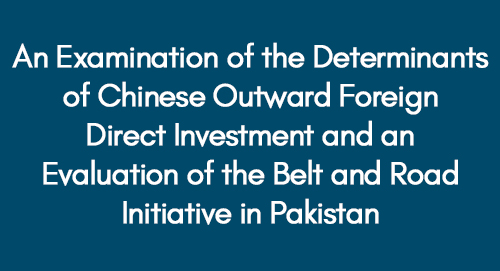
To Assess How Entrepreneurship and Innovation can Enhance Patient Safety Techniques-Case in the Healthcare Sector of the UK
June 15, 2022
Impact of Playing Extensive Video Games on Young Adults with Autism Spectrum Disorders
June 16, 2022Background of the Study
This study examines the factors influencing Chinese companies' investments in foreign countries and the reasons behind their choice of Pakistan as an investment destination. Additionally, it evaluates the impact of the Belt and Road Initiative on Pakistan. In the current age of rapid advancement and development, China is considered one of the fastest-growing economies that has captured different global markets through its excessive foreign direct investment (Zhang et al., 2017). Foreign Direct Investment (FDI) directly contributes to economic growth by injecting capital, technology, and managerial expertise into host countries, stimulating job creation, boosting productivity, and fostering overall economic development.
Figure out the Impact of FDI on Economic Growth in the UK
The study conducted by Liu et al. (2017) specified that the ‘going out strategy’ adopted by China in 2001 enabled the country's domestic firms to expand their business globally and participate in cross-border investments. In 2017, china's outward FDI investment amounted to 138.293 billion USD (World Bank, 2020). Pakistan is one of the leading investment hubs for China due to its peaceful cross-border relationships and friendly alliance (Kang et al., 2018). According to the State Bank of Pakistan, China has become the leading foreign investor in Pakistan by investing 501 million USD in 2019 for the development of the economic sector of the country (Xinhua, 2020). Foreign direct investments from China have always worked as the driving source for the economy of Pakistan due to the establishment of different development projects in the country that took place under the CPEC alliance (Huang, 2016).
China Pakistan Economic Corridor (CPEC) is the alliance between China and Pakistan that has helped in initiating the different infrastructure and development projects in Pakistan, such as the Sahiwal power plant, Gwadar port, Peshawar-Karachi motorway, and East Bay expressway (CPEC, 2020). Furthermore, the Belt and Road Initiative was another major infrastructure development project China started in 2013 that aims to connect Asia with Europe and Africa through marine networks and motorways (BRI, 2020). Karakoram Highway, Gwadar Port, Karachi circular railway, and the project of a direct transmission line from Lahore to Matiari are major projects undergoing the Belt Road initiative of China in Pakistan (SCMP, 2020). China's Belt and Road Initiative in Pakistan has witnessed new developments in concrete technology, playing a pivotal role in infrastructure projects. The integration of advanced concrete technologies not only accelerates construction processes but also enhances the durability and sustainability of critical developments under the initiative.
Strategic development of materials and systems
The study conducted by Liu et al. (2017) specified that market openness and geographical location are major determinants that encourage China to invest substantially in Pakistan. Kolstad and Wiig (2012) asserted that market size, geographic benefits, demand, and inflation determine outward FDI in China. China has always invested in Projects in Pakistan by focusing on the long-term benefits they can obtain from it (Khan, 2014). Gwadar Port is one of the major elements of CPEC and a potential investment of China in Pakistan because it can help to develop alternative shipping to transport oil in China (SCMP, 2020). China heavily relies on the Malacca Strait shipping route to trade oil in China, and Gwadar port lies near the Hormuz Strait, the leading oil shipping route in and out of the Persian Gulf (SCMP, 2020). Navigating a balancing act, China's Belt and Road Initiative in Pakistan encounters challenges in reconciling short-term incentives with the imperative for strategic, long-term investments. This delicate equilibrium is crucial for sustainable economic development, fostering collaboration, and ensuring the success of infrastructure projects under the initiative.
Aim and Objectives
The following study assesses the determinants of Chinese outward foreign direct investment and evaluates Pakistan's Belt and Road Initiative.
- To study the significance of the foreign direct investment in Pakistan
- To identify the determinants that drive the Chinese outward foreign direct investment in Pakistan
- To analyze the product analyses and Eco Redesign Strategy of China regarding the expansion in Pakistan through the Belt and Road initiative.
- To study the risk associated with receiving excessive foreign direct investments.
- To recommend the strategies for the government of Pakistan to manage the FDI from China efficiently.
Research Questions
- What determinants drive the Chinese outward foreign direct investment in Pakistan?
- What is the Belt and Road Initiative of China in Pakistan?
- What is the business strategy of China to expand in Pakistan?
- What is the risk associated with receiving excessive foreign direct investments?
Research Problem
Wintour (2018) reported that China invests much in Pakistan's development projects. However, the heavy reliance of Pakistan on China can create a negative impact on the internal stability of Pakistan. Excessive investment and involvement of China in key projects of Pakistan can lead the country's locals to lose the ownership of their assets to China or get suppressed by the Chinese investors (Duan et al., 2018). Therefore, this study can contribute to resolving this issue by studying the determinants that drive China's outward FDI in Pakistan.
Research Scope
This study mainly strives to address the determinants of Chinese outward investment and evaluate the OBOR initiative in Pakistan. The main scope is to address the determinants responsible for the construction of economics and procurement in Pakistan. The study attempts to address the impact of the CPEC initiative and quantifies the impact through the research method. The study mainly concentrates on the progression that is achieved in the context of Pakistan; thus, its scope is restricted to Pakistan, and Chinese initiatives were taken over there. Since outward FDI is a concept, the study is mainly restricted to concentrating on determinants of FDI in the context of the OBOR initiative in Pakistan.
Method
In this study, a mix of an ed-method research design has been selected because it offers the diversity to use of both qualitative and quantitative research paradigms. A secondary data collection method has been used to study the determinants that drive the FDI in Pakistan and evaluate the Belt and Road initiative. Qualitative design helps analyse the risks, opportunities, and impact of determinants associated with the FDI of China in Pakistan. Quantitative analysis has been employed to analyze the effectiveness of the FDI of China and the Belt Road Initiative on the economy of Pakistan by studying the different variables such as GDP, employment rate, and national income.
Structure of Study
The underlying study constitutes five chapters: introduction, literature, methodology, Finding/analysis, and conclusion sequentially. The introduction details the background, aim, method and problem addressed in the study. The literature section covers a detailed discussion of the topic using previous studies. The methodology includes the techniques and methods used to conduct the study. The finding and analysis chapter covers the investigation and results of the data collected. Lastly, the conclusion and recommendation chapter summarizes the study and concludes with recommendations.
Chinese Business Expansion in Pakistan
The China-Pakistan economic corridor is a bilateral economic relationship between Pakistan and China, where collaboration and coordination would be done in the trade, energy, and infrastructure trade sectors. Raza et al. (2018) highlighted that China mainly relies on outward foreign direct investment to expand its business activities in Pakistan. The economic development supports China in establishing trade relationships with central Asia and gaining quick access to the European market. The access and linkages to Gawadar reduce the China distance, allowing it to reduce transportation costs and gain widespread access. According to Ullah (2018), the business expansion in Pakistan is an attempt to transfer Chinese innovation to Pakistani firms.
It is financial aid for Pakistan’s decade-long struggle economy, allowing Pakistan to benefit from the synergy created through working with its Chinese counterpart. The insurgency of the neighbouring countries poses a mina threat to the business of Pakistan. In addition to the above statement, the study conducted by Yu (2017) explores the Chinese motivation toward the One Belt One Road Initiative (OBOR). It is revealed it is part of China’s foreign policy to build stable economic relationships and take advantage of the strategic location. The study denotes that OBOR is not just investment cooperation and economic interest but also focused on the political strategy of becoming a valuable leader of central Asia. OBOR will support China in resolving the industrial overcapacity and difficulty in technological up-gradation at home.
CPEC and its Significance
CPEC mainly has a range of strategic and economic significance for China and Pakistan. Iqbal (2017) states that the project has great geopolitical and geo-economic potential, providing major interconnectivity across Asia and the Middle Eastern region. The project would significantly uplift Islamabad and the northern region to represent South Asia, exerting a major strategic influence from China’s ends on the southern Chinese region. The estimated cost of the project is US$ 75 Billion, out of which US$45 Billion ensures to improve the regional optional by connecting the Gilgit-Baltistan region to the Kashgar region. The main significance to China can be explained by the fact that currently, China transports 80% of the Oil from Strait Malacca to Shanghai, which is spread over 16,000 km and takes 2-3 months; however, CPEC coming into play will reduce the distance 5000w. That ultimately helps in reducing the transportation cost. The intersection of transport, sustainability, and visionary planning is a cross-cutting exercise within China's Belt and Road Initiative in Pakistan. This holistic approach aims to integrate eco-friendly transport systems, ensuring sustainable development and realizing long-term visions for economic growth and regional connectivity. The major Energy projects will produce energy up to 16,400-megawatt, solving the major energy crisis. Besides economic development, CPEC holds major Socioeconomic opportunities for the Baluchistan and Gilgit-Baltistan region. According to Ali (2016), it can merely be indicated that CPEC has the potential to showcase productivity equivalent to 17% of Pakistan’s GDP in 2015; the project would heal the unemployment situation by creating 700,000 jobs.
Lessons from Chinese Investment in Africa
Ayodele and Sotola (2014) explore the Chinese investment in the African region, which is focused on increasing the FDI in the African region, promoting infrastructural development, stabilizing the prices of African products & commodities, and capitalizing on the natural resources that are found in Africa. The key driver of the economic corridor in Africa was to exploit the vast reserve of Oil and gas in Africa; the second major motive that Africa is seen to be a potential market for Chinese products and, importantly, the privatization of the enterprise in China that look forwards towards a potential investment. The research denotes that the Chinese seek to address the mutual benefit in the African region.
Impact of CPEC on Pakistan's Economy
When it comes to assessing the impact of CPEC on the economy of Pakistan, one notable study conducted by Ali et al. (2017) explores the impact of CPEC on the Pakistan economy; the research denotes that with CPEC working at its full potential, Pakistan enhances the GDP and its exports that would directly reflect on the economy. CPEC can support improving the GDP by 6%, which would eventually improve the unemployment situation in the country. The CPEC would also positively impact the bilateral trade due to the enhancement that would be made in Gawadar port. Apart from the economic benefits, the CPEC will also have a social impact on creating job opportunities and improving the standard of living. Chairman Gawadar Port Authority (GPA) states that the port can potentially create 40,000 jobs. Much of the Job creation from CPEC would possibly happen during the construction stages of the projects. This research sheds light on the outward foreign direct investment that China is mainly initiating in the form of the OBOR initiative. Economic development and economic development can be viewed from the Rostow linear stage development. It is revealed that economic progression happens in five stages. The stages mainly help determine the stage Pakistan and China are on and how long it would take. The stage is the traditional society stage, where agriculture is important, and many of the processes are labour-intensive. Next is the take-off stage, where the process of industrialization cultivates, technological innovation happens in the drive to maturity stage, and high mass consumption is the final stage (Kindleberger, Tella, and Tella, 2016). Pakistan is currently at the take-off stage where there is the presence of an industrial revolution; however, it slows because of political intervention. The mega project will also facilitate the exchange of culture and tradition and open a route to safe tourism in the Northern areas of Pakistan.
Research Philosophy
Pragmatism research philosophy has been used in the underpinned research. It allows evaluation of the different aspects of the study using different methods and techniques that help to reach a valid conclusion (Kumar, 2019).
Research Design
This study has selected a mixed-method research design because it offers diversity in using both qualitative and quantitative research paradigms. The mixed method was suitable for this study because it allows for comparing the different findings and reaching accurate results (Flick, 2015).
Data Collection and Analysis
A secondary data collection method has been used to study the determinants that drive the FDI in Pakistan and evaluate the Belt and Road initiative. The secondary data collection method has been used because this study demands extracting information related to the FDI investments of China from existing resources and reports. Therefore, this study gathered quantitative information from Journal articles, websites, reports, the World Bank, the OECD website, and Statista. Qualitative design helped analyse the risk, opportunities, and impact of determinants associated with the FDI of China in Pakistan. Quantitative analysis has been employed to analyze the effectiveness of the FDI of China and the Belt Road Initiative on the economy of Pakistan by studying the different variables such as GDP, employment rate, and national income. The data from 2010 to 2019 to study the influence of China's FDI and the Belt Road Initiative on Pakistan's economy can help address the research problem of whether excessive FDI of China is a risk to Pakistan. The content analysis technique has been used to analyze and evaluate qualitative information because it helps to explore the different aspects of the underlying phenomenon in detail (Mackey and Gass, 2015). However, time-series data analysis techniques have been used to analyse quantitative data.
CHAPTER 4: FINDINGS AND ANALYSIS
The findings and analysis of foreign direct investment in Pakistan reveal its significant role in the country's economic growth and the challenges it faces in attracting and retaining foreign investors.
Introduction
The following chapter is based on the analysis of the study using the secondary data for foreign direct investment in Pakistan for the Belt and Road initiative. The chapter has been divided into different sections according to the research requirements and for gaining the results afterwards. The study has assessed the significance of FDI in Pakistan and its determinants that can drive the Chinese to invest in Pakistan. The chapter has also discussed the business strategy toward expansion in Pakistan through the belt. Further analysis has been provided as follows;
Content Analysis
Foreign Direct Investment (FDI) in Pakistan is a critical component of the country's economic development. This content analysis delves into the trends, impacts, and challenges associated with FDI in Pakistan.
Foreign Direct Investment In Pakistan
FDI inflows have not been very high in the country after the peak fiscal year 2007-08. According to the report of UNCTAD (2019), the FDI has grown to 2.3 billion in 2018. Moreover, according to the assessment of the first half, the total ratio of FDI has reached USD 41 billion (13.4% of GDP) by the end of the year 2018. Moreover, according to the report of the State Bank of Pakistan (2019), the FDI inflows have increased by 63% according to the second half (July-dec 2019) and have reached USD 1.34 billion against the USD 798.8 million according to the report of the previous year within the same time of second half. According to the assessment of Nordeatrade (2020), the country has a huge domestic population of nearly 207 million. Moreover, the poverty level has also decreased with the increase in FDI within the country.

Pakistan has also faced massive growth within the year 2017 by 5.2%. However, according to the arguments of Tradingeconomics (2020), the country also has a massive security threat from the US and other Western countries. Security threats have been one of the major issues for initiating the OECD Anti-corruption Convention in the country.
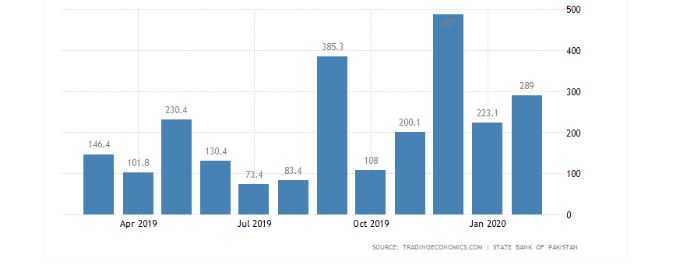
The statistics show that the country Pakistan has an average of 162.51 USD billion and reached 1262.90 USD Million in June of 2008. However, the country has also faced a low record of -367.50 USD Million in October of 2018.
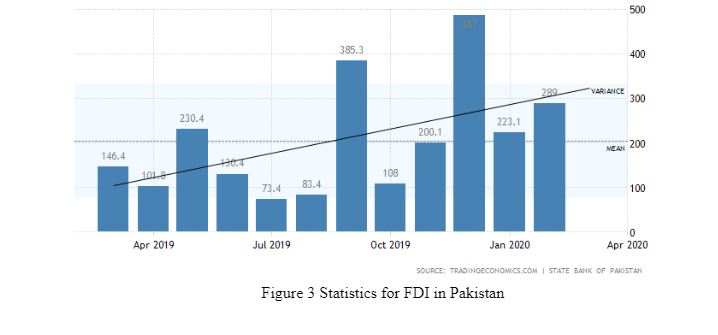
Determinants that Drive the Chinese Outward Foreign Direct Investment in Pakistan
According to the analysis of Rippa (2019), the Chinese and Pakistani trade relationship is effective, leading China to carry out the means of investment within the country. Some of the major reasons and determinants that have been attracting investment measures are energy, trade, green infrastructure, and other sectors. China has found the major transportation access from Gwadar, an innovative spread for the firms in Pakistan. According to The Express Tribune (2016), China has supported Pakistan regarding FDI in the year 2015-16 respectively. The net inflow is nearly $600 million for FDI in Pakistan. Due to one of the major reasons for having an economic corridor (CPEC), China has been investing a huge share within the country for better trade opportunities in the future, according to Thediplomat.com. (2020).
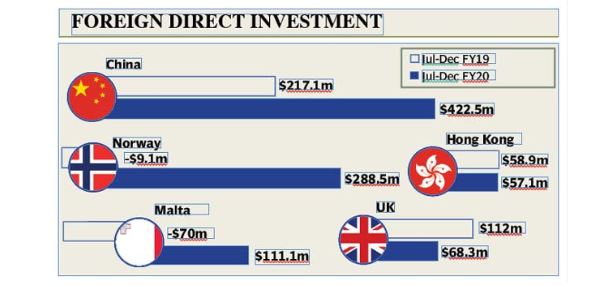
Business Strategy of China Regarding the Expansion In Pakistan Through Belt and Road Initiative
The projects that are under the Belt and Road Initiative (BRI) are mainly designed by the government of China for developing the means of infrastructure, transport, energy, and IT and communication. It has been designed to develop and improve the industrial parks and the two countries' growth. According to the assessment by Hussain (2017), these Belt and Road initiatives have been designed for the betterment of the country and better sustainability in the future.

According to the analysis of Ramay (2016), there is an infrastructure need within the country that is effective for the IT and communication system within the country.
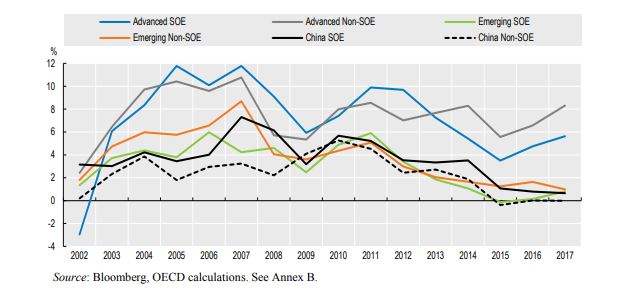
China’s global infrastructure projects are thereby millions of dollars from 2005 to 2017. The total investment is there within the projects with a sum of USD 480.3 billion, according to Khursheed et al. (2019). Additionally, the construction projects in China are smaller than in the OECD countries. Therefore, these belt initiatives have gained much more importance, creating opportunities for further telecommunication and IT.
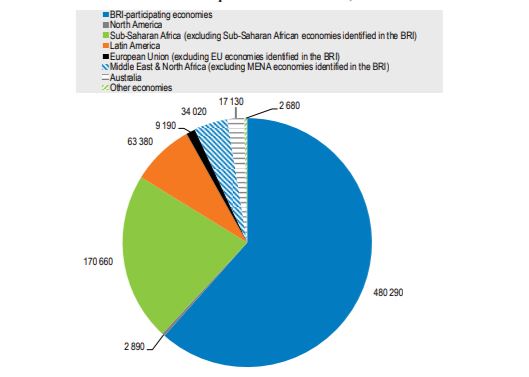
Risks Associated with Receiving Excessive Foreign Direct Investments
According to the assessment of Nielsen, Asmussen, and Weatherall (2017), it has been observed that excessive foreign direct investment has been effective for the countries as it has been increasing the means and opportunities for businesses. However, Sarkodie and Strezov (2019) have argued that excessive means of investment can also be risky for the countries as it creates aspects of hindrance and domestic investment for further businesses. Moreover, the countries also face the issue of negatively influencing the country's exchange rate. Furthermore, Pakistan is a country that has a low exchange rate. The excessive use of foreign investment can cause a major decrease in the exchange rate in the country respectively.
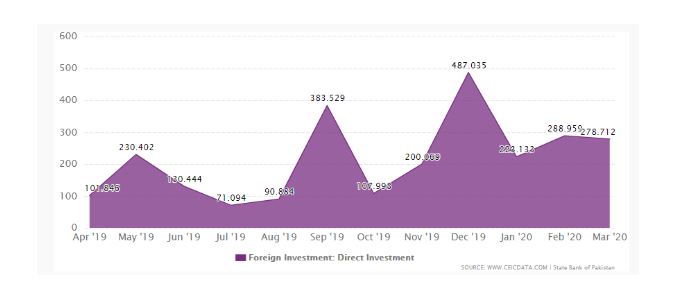
According to the above-mentioned statistics, it has been observed that Pakistan has been gaining increased FDI from China, which is fruitful for the projects on the one hand and can also ruin the country’s performance on the other hand. The stats belong from Apr 19 to Mar 20 for the whole year and have affected the company’s performance at a higher rate.
Discussion
The following research is based on different objectives that the researcher has designed to achieve the results. Moreover, it has been observed that the researcher has achieved the research objectives by assessing the secondary data collected from different sources. The first objective of the research was to study the significance of foreign direct investment in Pakistan. The researcher has assessed the following factors by investigating the factors of FDI from China through the means of belt and road projects in the country. The study has been supported by the discussions of Khursheed et al. (2019). The researcher has also aimed to identify the determinants that drive the Chinese outward foreign direct investment in Pakistan. These determinants are found to be the ease of trade, transport, telecommunication, and IT that can be effective for dealing with the use of trade routes in China. Another research objective the researcher has designed is to study the risk associated with receiving excessive foreign direct investments. The researcher has discussed that the excessive use of FDI in the country may affect the current economy and can also affect the exchange rate in the country at a higher rate. The researcher has also provided the fact supported by the discussions of Rippa (2019) that excessive FDI from other countries can also ruin the country's performance and its exchange rate.
CHAPTER 5: CONCLUSION AND RECOMMENDATION
The following chapter has provided the conclusion and recommendations of the above research on the determinants of Chinese outward foreign direct investment and an evaluation of Pakistan's Belt and Road initiative. The chapter has highlighted the summarized findings and major key points that the researcher has concluded after conducting the assessment.
Summarized Findings
The following study is based on the Belt and Road projects that are being performed in China and Pakistan to provide ease in terms of transport, trade, and other means of communication in the two countries. The research has adopted the findings that the FDI inflows have increased by 63% according to the second half (July-dec 2019) and have reached USD 1.34 billion against the USD 798.8 million according to the previous year's report within the same time of the second half. The researcher has provided the findings that the country also has a massive security threat from the US and other Western countries. The increasing investment in the country for building different projects is effective in one aspect. However, the excessive use of these investments can be poor for the countries in terms of impacting the company’s performance and exchange rate.
Conclusion
After conducting the assessment on the following topic, it has been concluded that the countries Pakistan and China have been looking forward to the inauguration and building of Belt and Road programs within the country to generate more profit and increase the means of trade in the countries. The port itself has the potential to create 40,000 jobs. Much of the Job creation from CPEC would possibly happen during the construction stages of the projects. It has been further conceded that the rate of FDI has been increasing in Pakistan, which may affect the current performance of the country and its exchange rate. However, the increasing rate of this FDI can also ruin the country’s image for further business and investment.
Recommendations
Based on the study that has been carried out, it has been recommended that the country of Pakistan make interventions to increase the means of business and generate higher returns. Moreover, it shall reduce China's FDI rate or make certain project partnerships. In addition, initiatives should be taken regarding physical infrastructure, as BRI can help stimulate FDI growth along with Pakistan's GDP and trade growth. Furthermore, the investment allocation should also be considered with the great heterogeneity expected in the different geographic areas and projects. The BRI initiative should be implemented in Pakistan as it will help the country's poverty alleviation and social development and further provide different business and employment opportunities to enhance their income level. In addition, the rural areas of Pakistan will be helped greatly by this initiative as it will create drastic changes and bring infrastructure development and prosperity.
Future Implications
The following research is based on the case of FDI and growth in the country of Pakistan. Future research can also be carried out on the topic of growth and economic downturn within the country. The ideas for increasing the country's revenue can also be improved.
References
Ali, L., Mi, J., Shah, M., Shah, S.J. and BiBi, K., 2017. The potential socio-economic impact of the Pakistan economic corridor. Asian Development Policy Review, 5(4), pp.191-198.
Ali, M., 2016. Significance of CPEC in East Asia Countries & Its Impact on Pakistan's Economy. Available at SSRN 3527953.
Ayodele, T. and Sotola, O., 2014. China in Africa: An evaluation of Chinese investment. Initiative for Public Policy Analysis, pp.1-20.
BRI. 2020. Belt and Road Initiative (BRI).
CPEC. 2020. Gwader | China-Pakistan Economic Corridor (CPEC) Official Website, Cpec.gov.pk.
Duan, F., Ji, Q., Liu, B.Y. and Fan, Y., 2018. Energy investment risk assessment for nations along China’s Belt & Road Initiative. Journal of cleaner production, 170, pp.535-547.
Flick, U., 2015. Introducing research methodology: A beginner's guide to doing a research project. Sage.
Huang, Y., 2016. Understanding China's Belt & Road initiative: motivation, framework and assessment. China Economic Review, 40, pp.314-321.
Hussain, E., 2017. China–Pakistan economic corridor: will it sustain itself? Fudan Journal of the Humanities and Social Sciences, 10(2), pp.145-159.
Iqbal, K., 2017. Significance and security of CPEC: A Pakistani perspective. China Int'l Stud., 66, p.132.
Kang, L., Peng, F., Zhu, Y. and Pan, A., 2018. Harmony in diversity: can the One Belt, One Road initiative promote China’s outward foreign direct investment? Sustainability, 10(9), p.3264.
Khan, A.U., 2014. Pak-China economic corridor: The hopes and reality. Regional Studies, 33(1), pp.45-63.
Khursheed, A., Haider, S.K., Mustafa, F. and Akhtar, A., 2019. China–Pakistan economic corridor: a harbinger of economic prosperity and regional peace. Asian Journal of German and European Studies, 4(1), pp.1-15.
Kindleberger, C.P., Di Tella, G. and Di Tella, G., 2016. Economics in the Long View: essays in honour of WW Rostow. Springer.
Kolstad, I. and Wiig, A., 2012. What determines Chinese outward FDI? Journal of World Business, 47(1), pp.26-34.
Kumar, R., 2019. Research methodology: A step-by-step guide for beginners. Sage Publications Limited.
Liu, H.Y., Tang, Y.K., Chen, X.L. and Poznanska, J., 2017. The determinants of Chinese outward FDI in countries along “One Belt One Road”. Emerging Markets Finance and Trade, 53(6), pp.1374-1387.
Liu, H.Y., Tang, Y.K., Chen, X.L. and Poznanska, J., 2017. The determinants of Chinese outward FDI in countries along “One Belt One Road”. Emerging Markets Finance and Trade, 53(6), pp.1374-1387.
Mackey, A. and Gass, S.M., 2015. Second language research: Methodology and design. Routledge.
Nielsen, B.B., Asmussen, C.G. and Weatherall, C.D., 2017. The location choice of foreign direct investments: Empirical evidence and methodological challenges. Journal of World Business, 52(1), pp.62-82.
Nordeatrade.com. 2020. Foreign direct investment (FDI) in Pakistan - Investing - Nordea Trade Portal.
Ramay, S.A., 2016. China Pakistan economic corridor: A Chinese dream being materialized through Pakistan.
Raza, H., Mohiuddin, Z.A., Zaidi, S.S.Z. and Osama, A., 2018. CPEC: Pakistan-China Cordial Ties-A Boost to Pakistan's Economy. Journal of Accounting, Business and Finance Research, 2(1), pp.1-6.
Rippa, A., 2019. Cross-Border Trade and “the Market” between Xinjiang (China) and Pakistan. Journal of Contemporary Asia, 49(2), pp.254-271.
Sarkodie, S.A. and Strezov, V., 2019. Effect of foreign direct investments, economic development and energy consumption on greenhouse gas emissions in developing countries. Science of the Total Environment, 646, pp.862-871.
SCMP. 2020. Five top Chinese investments in Infrastructure Plan’s Pakistan arm (2017). 15-16: China helps as FDI in Pakistan surges 38.8% | The Express Tribune. [
Thediplomat.com. 2020. Chinese investment in Pakistan – The Diplomat.
Tradingeconomics.com. 2020. Pakistan Foreign Direct Investment | 1997-2020 Data | 2021-2022 Forecast | Historical.
Ullah R (2018) Importing Chinese Innovation to Pakistani Firms in China Pakistan Economic Corredor. J Bus Fin Aff 7: 358. doi: 10.4172/2167-0234.1000358
Wintour, P. 2018. 'All-weather friendship': but is Pakistan relying too heavily on China?, the Guardian.
WorldBank. 2020. Foreign direct investment, net outflows (BoP, current US$) - China, Pakistan | Data.
Xinhua. 2020. China continues as the leading foreign investor in Pakistan: the central bank.
Yu, H., 2017. The motivation behind China’s ‘One Belt, One Road Initiatives and establishing the Asian infrastructure investment bank. Journal of Contemporary China, 26(105), pp.353-368.
Zhai, F., 2018. China’s belt and road initiative: A preliminary quantitative assessment. Journal of Asian Economics, 55, pp.84-92.
Zhang, R., Andam, F. and Shi, G., 2017. Environmental and social risk evaluation of overseas investment under the China-Pakistan Economic Corridor. Environmental monitoring and assessment, 189(6), p.253.
Get 3+ Free Dissertation Topics within 24 hours?

















